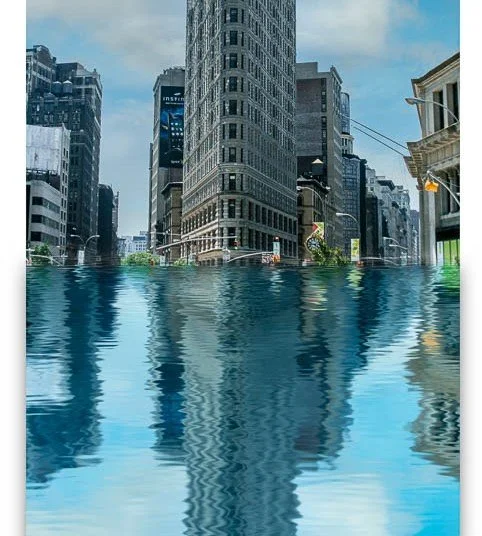Future Mid-Town Manhattan, by Paul VanDerWerf on flickr https://www.flickr.com/photos/pavdw/51906333819
It's 2140, and the most popular reality TV show is a live-stream of Amelia Black transporting polar bears to the Antarctic in her airship as part of assisted migration. In New York, housing is run by cooperatives and buildings have been waterproofed below the high tide line. Sky-scrapers have had docks added part-way up for speed boats, and there are floors dedicated to food growing. This is the setting of Kim Stanley Robinson's New York 2140, a classic of post-climate fiction with an optimistic outlook.
What will our sustainable society look like, when we've met all the science-based targets, and everyone lives with their inalienable human rights fully respected, in a world altered by the climate change we're already committed to? It's hard to imagine just how much things may change, when we start by projecting forward from here.
To build a better world, we need to imagine it. Which is where artists of all kinds - including but not only fiction writers - can really help us.
If you're in London before the end of August, you could visit Our Time on Earth, an exhibition at the Barbican arts centre. The exhibition includes 18 different artistic responses, which explore how we might live sustainably and what that would look and feel like. The curators say "We wanted Our Time on Earth to carve out space to imagine a constructive way forward."
What does this constructive way forward look like?
There's metaphor, like the dining table set for sharing a meal with different species including wasp, snake, beaver, raven and mushroom. I was captivated by the video installation window at the end of the table, showing a more literal - if still idealistic - vision of a flooded city and how it can be reclaimed by plants and animals, and with people living in different ways. You can watch this by scrolling down in the page linked to at the start of this paragraph.
There was a beautiful film, Wild Arrow #7, by Selvagem, which used animation and documentary, with a poetic narration, to explore indigenous ways of seeing our environment, contrasted with commodification of everything by colonial invaders. The earlier films in the series are on their website.
In the Symbiocene, there were scale models of cities and landscapes overlaid with projections showing temperature responding to tree cover, nutrient flows responding to different ways of managing water, and floating infrastructure.
Intellectual property and contracts were reimagined in the "Smart Oath of Understanding" agreed between indigenous collaborators and engineering company Buro Happold. The importance of the socio-cultural dimensions, not just the engineering, also showed up in the Subak irrigation system for rice terraces in Bali which works because it includes monthly consensus-building discussions about what is a fair flow of water between different parts of the system, given the human and ecological needs and the work put into it by different people.
Less systemic, but still fascinating, was the use of mycellium (fungi), brewed proteins (from a sugar feedstock) and algae (seaweed) as new textiles and fabrics. But will they just end up getting exploited in the same way current crops and landscapes are exploited, in a one-to-one substitution for leather and cotton?
The future is up to all of us. Just imagine!
Here are a few more sources
Some books I read as part of getting to know eco-utopian and feminist utopian fiction: Herland; Woman on the Edge of Time; The Fifth Sacred Thing; Ecotopia; Always Coming Home; New York 2140.
There's a new genre of science fiction or speculative fiction called Solar Punk. Find out more.
And for current positive stories based on the here-and-now, see Positive News and the podcast from Transition Town's Rob Hopkins From What If To What Next. (The link takes you to Apple's podcast page. Other platforms are available.)
Making the Path by Walking
This piece was first published in my more-or-less monthly newsletter, Making the Path by Walking. Scroll right down to subscribe.

